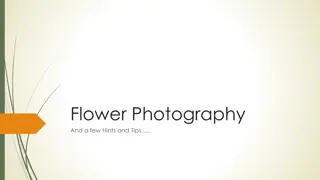Understanding Composition in Photography
Composition in photography involves the arrangement of shapes and forms, their relationship to one another and the overall image. It plays a crucial role in determining the effectiveness of a photograph and conveying its message. Elements like space, line, shape, color, texture, form, and value all contribute to creating well-composed and impactful images.
Download Presentation

Please find below an Image/Link to download the presentation.
The content on the website is provided AS IS for your information and personal use only. It may not be sold, licensed, or shared on other websites without obtaining consent from the author. Download presentation by click this link. If you encounter any issues during the download, it is possible that the publisher has removed the file from their server.
E N D
Presentation Transcript
Composition (The elements)
What is Composition Composition is the arrangement of shapes (forms) in an image their position, relationship to one another and to the image as a whole. Photographers, like other artists, compose their images to create certain effects and to affect the viewer.
How you arrange a scene's elements in your camera's viewfinder will not only determine the effectiveness of your picture, but will also contribute to how well its message is conveyed. There is more to good composition, than the placement of elements. Lighting, shutter speed, and depth of field and aperture contribute to a picture's mood and clarity of what the picture is saying, and therefore the effectiveness of its composition.
Elements of Design Space - Space is defined and determined by shapes and forms. Positive space is where shapes and forms exist; negative space is the empty space around shapes and forms. For images to have a sense of balance positive and negative space can be used to counter balance each other. Line - A line represents a "path" between two points. A line can be straight, curved, vertical, horizontal, diagonal, or zigzag. Shape - Shapes are the result of closed lines. However shapes can be visible without lines when an artist establishes a color area or an arrangement of objects within the camera's viewfinder. Color - Color occurs when light in different wavelengths strikes our eyes. Texture - Texture refers to the surface quality or "feel" of an object - smooth, rough, soft, etc. Textures may be actual (felt with touch - tactile) or implied (suggested by the way an artist has created the work of art -visual). Texture is often emphasized in oblique lighting as it strikes the objects from one side. Form - Form refers to the three-dimensional quality of an object, which is due in part to light, and dark areas. Light and dark areas within an image provide contrast that can suggest volume Value - Value helps with Form. It gives objects depth and perception. Value is also referred to as tone.
More about Space Positive and Negative Space: Positive space is where shapes and forms exist. Negative space is the empty space around shapes and forms. The next few slides will help to see the positive and negative space in photographs
Positive Space The positive space masked in black
Negative Space The negative space masked in black notice how the negative space defines and implies the shape of a plane Negative space helps define a subject, so negative space works when there s a balance between the positive and negative spaces. Negative space also works when it draws the viewer s eye into the subject.
Negative Space Negative space can actually be used as the main subject in a composition itself, sometimes to the extent where it takes on an identifiable shape defined by its surrounding positive space. Photography by Numlok
Balancing Negative and Positive Space In this photo the black area is negative space and it serves to balance the area in which the marmot and rock occupy. Areas of a picture that contain "nothing" are important visual elements that provide balance in an image.
Examples Photography by Faquino101 Photography by Stephen M. Gray
Line Diagonal, Horizontal, Vertical and Converging, Leading lines all impact images differently when photographing use the lines to strengthen the images. Photography by Stevacek Lines have the power to lead the viewers eye to certain points in the image.
Diagonal Lines Diagonal lines generally work well to draw the eye of an image s viewer through the photograph. They create points of interest as they intersect with other lines and often give images depth by suggesting perspective.
Horizontal Lines There s something about a horizontal line in an image that conveys a message of stability or even rest . Photography by Tal Bright
Vertical Lines Vertical lines have the ability to convey a variety of different moods in a photograph ranging from power and strength (think of skyscrapers) to growth (think of trees).
Converging Lines A picture with converging lines contains a set of lines which seem to come together in the distance. Photography by Kenny Maths *Experiment with Positioning *Positioning the convergence *Adding Interest at the Point of Convergence Photography by MarvinOS
Leading Lines Leading lines are used to draw the viewer's eye through the photograph. This is an especially powerful technique to draw the viewer's attention to one or more intended subjects or a single focal point.
Shape In photographs, shape can be the objects in the image, but they can also be the way subjects connect to each other in a photo to form shapes that draw the eye from subject to subject. Photography by Wong Chek
Texture Texture helps to emphasize the features and details in a photograph. By capturing "texture" of objects, you can create form. Photography by Grant McDonald Texture particularly comes into play when light hits objects at interesting angles. Photography by Scose
More about Color Hue: refers to the names of the primary colors, red, green and blue. Color Terms Value: lightness and darkness of the color - the amount of white or black added. Intensity: the purity or saturation of the color Monochromatic color: use of one color where only the value of the color changes Analogous colors: colors that are adjacent to each other on the color wheel, e.g. yellow and green
Analogous Color Analogous colors next to each other on the color wheel "get along" and are referred to as being harmonious. Analogous colors are often used in visual design and have a soothing affect.
Complementary Colors Complementary colors: colors opposite to each other on the color wheel, e.g. Blue-violet and yellow, represent colors positioned across from each other on the color wheel. Complimentary colors exhibit more contrast when positioned adjacent to each other - for example yellow appears more intense when positioned on or beside blue or violet
Warm Colors Warm colors include: yellows, red and orange we associate these with blood, sun and fire. Warm colors make you feel energized.
Cool Colors Cool colors include: violet, blue and green because of our association with snow and ice. Cool colors invoke sadness. This image is monochromatic.
http://www.alifetimeofcolor.com/study/g_cool_colors.html http://www.alifetimeofcolor.com/study/g_warm.html http://www.tutorial9.net/resources/enhancing-your-art-with-negative- space/ http://en.wikipedia.org/wiki/Design_elements_and_principles http://photoinf.com/General/Robert_Berdan/Composition_and_the_Elem ents_of_Visual_Design.htm http://www.flickr.com/photos/blind_eye_frank/351442724/ http://www.layersmagazine.com/negative-space.html http://www.digitalphotoguides.com/composition2.html http://digital-photography-school.com/converging-lines http://www.photographyicon.com/line/index.html http://www.catfolks.net/sean/photos/OakGlenTrip052707/ http://www.photips.com/photography-tips/leading-lines.html























